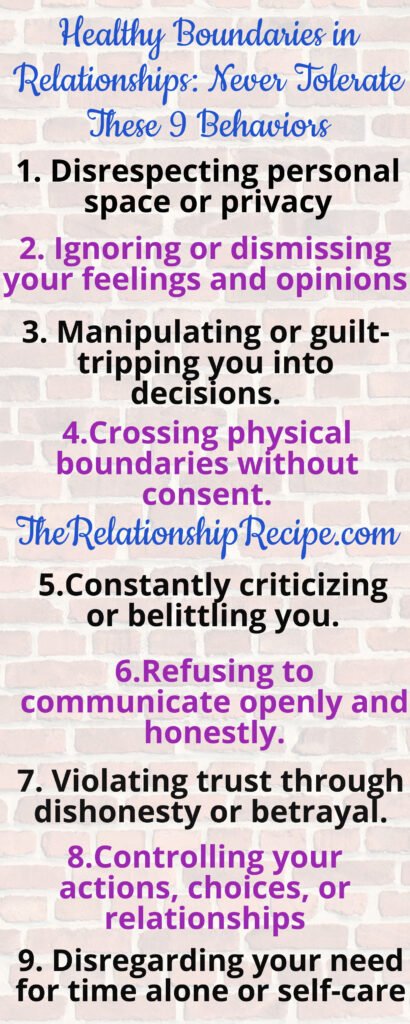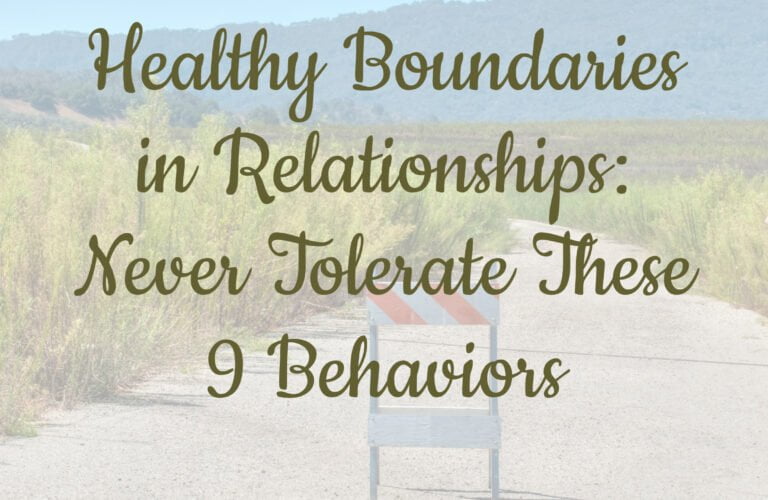In cultivating fulfilling and respectful relationship limits, maintaining healthy boundaries in relationships is paramount. Whether with friends, family, or romantic partners, setting clear examples of healthy boundaries ensures mutual respect, understanding, and emotional well-being.
To uphold examples of healthy boundaries, there are certain behaviors I never tolerate. These nine practices serve as my guiding principles in encouraging healthy and fulfilling relationships, safeguarding both my own integrity and the integrity of others.
When setting healthy boundaries in relationships, it’s important to make it known that there will be consequences if your relationship limits are crossed….and stick to them!
Healthy Boundaries in Relationships: The Foundation for Mutual Respect
In any healthy relationship, boundaries are essential. Without clearly defined boundaries, it’s easy for lines to become blurred, leading to confusion, resentment, and even toxic behavior patterns. By setting, and respecting healthy boundaries in relaltionships, couples can encourage a dynamic of mutual understanding, trust, and care.
For myself and many of us, setting healthy boundaries in relationships can seem like a daunting task. As women, especially – setting relationship limits might seem like we are being “rude,” or “harsh” so it’s a hard concept for some of us less aggressive people to wrap our heads around.
If there is one valuable lesson I’ve learned, it is that we “teach” others how to treat us by what we are willing to endure.
I have been guilty of this with my husband. I admit some relationship limits are harder to enforce than others, especially if you are with someone who is high conflict.
On the other hand, his dismissiveness and stonewalling also taught ME how to treat him, if I want to keep the peace, which comes in the form of emotional detachment on my end. I could not see another way of dealing with it, while maintaining a semblence of sanity between us.
Now, I know that if I had set examples of healthy boundaries early on, we may not be in the throes of a failing marriage. Unfortunately, I was in my early 20s when I met him, pre-internet, and gullible as hell. I would’ve had no idea what healthy boundaries in relationships were, let alone how to enforce them.
Fortunately, it’s not 1994 and I am here to help you avoid making my relationship mistakes. In fact that is the whole purpose of this blog. I am telling you my long story of relationship blunders and the lessons I learned here.

. . . .
9 Behaviors to Never Tolerate When Setting Relationship Limits
Let’s discuss the key examples of setting healthy boundaries in relationships that should be established for a truly fulfilling connection.
- Disrespecting personal space or privacy
The behavior of disrespecting personal space or privacy, can manifest in various ways, such as invading physical boundaries, snooping through personal belongings, or pressuring for disclosure of private information.
Here’s an example of how to set a boundary in this scenario:
Example: If your partner frequently enters your personal space without permission, you might say, “I feel uncomfortable when you go through my phone without asking. I value my privacy and need you to respect that. Let’s agree to ask each other before accessing personal belongings.”
This sets clear relationship limits for respect of personal space and privacy.
2. Ignoring or dismissing your feelings and opinions
The behavior of ignoring or dismissing your feelings and opinions, can lead to feelings of invalidation, frustration, and resentment in a relationship.
Here’s an example of how to set a boundary in this scenario:
Example: If your partner frequently brushes off your emotions or opinions, you might say, “When you dismiss my feelings or opinions, it makes me feel unheard and unimportant. I need you to listen and validate my perspective, even if we disagree. Let’s work on actively listening to each other without judgment.”
This communicates the importance of mutual respect and validation in communication, setting a clear expectation for acknowledging each other’s feelings and opinions.

3. Manipulating or guilt-tripping you into decisions.
Manipulating or guilt-tripping you into decisions involves using emotional manipulation tactics to coerce or control your choices, often by making you feel guilty or responsible for their feelings. This lack of relationship limits can erode trust and autonomy within the relationship.
Here’s an example of how to set a boundary in this scenario:
Example: If your partner frequently uses guilt-tripping to influence your decisions, you might say, “I’ve noticed that you often use guilt to get your way, and it’s not healthy for either of us. I need us to communicate openly and make decisions together without resorting to manipulation. Let’s find a way to address our needs and concerns respectfully.”
This sets a clear expectation for open communication and mutual decision-making, while also asserting your boundaries against manipulative behavior.
4. Crossing physical boundaries without consent.
Crossing physical boundaries without consent, involves any actions or behaviors that violate your personal space or comfort levels without your explicit permission. This can include unwanted touching, invading personal space, or pressuring for physical intimacy. Such lack of relationship limits can lead to feelings of discomfort, violation, and even trauma.
Here’s an example of how to set a boundary in this scenario:
Example: If your partner frequently crosses physical relationship limits without your consent, you might say, “I feel uncomfortable when you initiate physical contact without asking first. It’s important for me to have control over my own body and to feel respected in our relationship. I need you to always ask for my consent before touching me or initiating intimacy.” This communicates your need for bodily autonomy and sets a clear expectation for respect and consent in physical interactions within the relationship.
5. Constantly criticizing or belittling you.
Constantly criticizing or belittling you, involves consistently demeaning or undermining your thoughts, actions, or worth, which can lead to feelings of inadequacy, self-doubt, and diminished self-esteem. Such behavior is detrimental to a healthy relationship and can erode trust and mutual respect.
Here’s an example of how to set a boundary in this scenario:
Example: If your partner frequently criticizes or belittles you, you might say, “I’ve noticed that you often make hurtful comments about my choices or abilities, and it’s taking a toll on my self-esteem. It’s important for me to feel supported and respected in our relationship. I need you to refrain from criticizing or belittling me and instead offer constructive feedback or support.” This communicates your need for positive reinforcement and sets a clear expectation for respectful communication within the relationship.

6. Refusing to communicate openly and honestly.
Refusing to communicate openly and honestly involves withholding information, avoiding important conversations, or being evasive or dishonest in communication. Such behavior can lead to misunderstandings, mistrust, and a lack of intimacy within the relationship.
Here’s an example of how to set a boundary in this scenario:
Example: If your partner consistently refuses to communicate openly and honestly, you might say, “I’ve noticed that you often avoid important conversations or withhold information, and it’s making it difficult for me to feel connected and secure in our relationship. Open and honest communication is essential for building trust and intimacy. I need us to be transparent and truthful with each other, even if it’s uncomfortable.” This communicates your need for transparency and sets a clear expectation for open and honest communication within the relationship.
7. Violating trust through dishonesty or betrayal.
The behavior of violating trust through dishonesty or betrayal, involves breaking promises, lying, cheating, or engaging in behaviors that betray the trust of your partner. Trust is the foundation of any healthy relationship, and breaches of trust can cause significant emotional harm and damage the relationship’s integrity.
Here’s an example of how to set a boundary in this scenario:
Example: If your partner has violated your trust through dishonesty or betrayal, you might say, “I’ve discovered that you’ve been dishonest with me, and it’s deeply hurtful. Trust is essential for me in our relationship, and I cannot tolerate further breaches of honesty or betrayal. I need us to be transparent and faithful to rebuild trust. If this behavior continues, I will need to reassess the future of our relationship.” This communicates your need for honesty and trustworthiness and sets a clear boundary regarding the consequences of further dishonesty or betrayal.

8. Controlling your actions, choices, or relationships
Controlling your actions, choices, or relationships, involves exerting power or influence over you to dictate your behavior, limit your autonomy, or isolate you from others. This behavior can manifest in various forms, such as dictating who you can spend time with, how you should dress, or what decisions you should make. Such control tactics can erode your sense of independence, self-worth, and happiness within the relationship.
Here’s an example of how to set a boundary in this scenario:
Example: If your partner exhibits controlling behavior by dictating your actions or choices, you might say, “I’ve noticed that you often try to control aspects of my life, such as who I spend time with or what decisions I make. This makes me feel suffocated and undermines my autonomy. I need you to respect my independence and trust me to make my own choices. We can discuss decisions together, but ultimately, I need to have the freedom to live my life on my own terms.” This communicates your need for autonomy and sets a clear relationship limit against controlling behavior.
9. Disregarding your need for time alone or self-care
Disregarding your need for time alone or self-care involves neglecting your requests for personal space or self-care activities, such as relaxation, hobbies, or mental health practices. This behavior can lead to feelings of overwhelm, burnout, and resentment, as your need for self-care and recharge time is not being honored.
Here’s an example of how to set a boundary in this scenario:
Example: If your partner disregards your need for time alone or self-care, you might say, “I’ve noticed that you often disregard my requests for personal time or self-care activities. Taking care of my mental and emotional well-being is important for me to be present and engaged in our relationship. I need you to respect my need for alone time and support me in prioritizing self-care. Let’s find a balance where we both have the space and time we need to recharge.” This communicates your need for self-care and sets clear relationship limits regarding the importance of honoring personal time within the relationship.

Healthy Communication
Communication is the lifeblood of any relationship, and healthy communication relationship limits are essential. Effective communication involves active listening, openly expressing thoughts and feelings, and a willingness to understand each other’s perspectives.
It’s important to set boundaries around communication styles, such as avoiding criticism, contempt, defensiveness, and stonewalling – behaviors that can quickly erode intimacy.
Establishing healthy communication relationships limits also means respecting each other’s need for personal space and alone time. Sometimes, we need a break from constant interaction to recharge and reflect. By setting boundaries around personal time and understanding the importance of me-time, couples can prevent feelings of suffocation or resentment from building up.
Maintaining open communication while upholding boundaries requires effort from both partners. However, the benefits are well worth it – stronger emotional intimacy, deeper understanding, and a more harmonious dynamic.

Here are some examples of healthy boundaries in the realm of communication:
Here are concise examples of communication relationship limits along with an example of setting one:
Respecting each other’s opinions without interrupting.
Example: “Let’s agree to listen to each other without interrupting when discussing important decisions.”
Avoiding blame and criticism during discussions.
Example: “Can we refrain from blaming each other when resolving conflicts? Let’s focus on finding solutions instead.”
Setting limits on communication frequency.
Example: “I need some time to focus on work during the day. Let’s limit non-urgent texts to after work hours.”
Being honest and transparent about feelings.
Example: “It’s important for me to know if something is bothering you. Can we promise to be open about our emotions?”
Respecting time for reflection before responding to important discussions.
Example: “I need some time to think before discussing this further. Can we revisit it tomorrow?”
Establishing communication relationship limits like these encourages understanding, trust, and healthy interaction within the relationship.

Emotional Boundaries
Emotions are an integral part of any romantic relationship, but it’s essential to manage them in a healthy way. Emotional relationship limits involve expressing emotions effectively while respecting each other’s emotional independence.
This means avoiding codependent behavior patterns, such as trying to control or manipulate each other’s emotions, or relying on your partner to meet all your emotional needs.
Setting emotional relationship limits also involves recognizing and respecting each other’s emotional limits. For example, if one partner is going through a difficult time and needs space to process their emotions, the other should respect that boundary without taking it personally.
By encouraging emotional independence while still supporting each other, couples can maintain a sense of balance and avoid the pitfalls of total emotional enmeshment.

Here are concise examples of emotional healthy boundaries in relationships along with an example of how to set them:
Expressing feelings without fear of judgment.
Example: “I need you to listen to me without interrupting when I share my emotions.”
Respecting each other’s emotional space.
Example: “I understand you want to help, but sometimes I need time alone to process my feelings.”
Avoiding emotional manipulation or guilt-tripping.
Example: “It’s not fair to guilt-trip me into doing something I’m not comfortable with. Let’s discuss it openly instead.”
Honoring each other’s emotional needs.
Example: “I need reassurance sometimes. Can we agree to validate each other’s feelings without dismissing them?”
Setting boundaries around discussing sensitive topics.
Example: “I’m not ready to talk about this right now. Can we revisit it later when I’m feeling more comfortable?”
Setting boundaries like these helps ensure emotional well-being and respect within the relationship.

Physical Boundaries
Physical intimacy is a cornerstone of romantic relationships, but it’s important to set and respect physical relationship limits. These boundaries encompass everything from personal space to sexual consent, and they should be established and upheld with care and respect.
It’s important to communicate openly about physical relationship limits, whether it’s setting limits around physical touch, personal space, or sexual intimacy. Each partner should feel comfortable expressing their needs and boundaries without fear of judgment or coercion. Respecting physical boundaries is not only essential for building trust and consent, but it also helps maintain a sense of individuality and personal autonomy within the relationship.

Here are concise examples of physical healthy boundaries in relationships along with an example of setting them:
Respecting personal space and autonomy.
Example: “I need some space right now. Can we sit apart for a bit?”
Asking for consent before physical contact.
Example: “Is it okay if I hug you?”
Setting limits on intimacy.
Example: “I’m not comfortable going further than kissing right now. Let’s take things slow.”
Respecting each other’s comfort levels with physical affection.
Example: “I understand you like holding hands, but I prefer not to do it in public.”
Establishing boundaries around personal belongings.
Example: “I’d prefer if you ask before borrowing my things.”
Setting physical relationship limits like these helps ensure comfort, safety, and respect within the relationship.
Remember, boundaries in physical intimacy are not a one-time discussion; they can shift and evolve as the relationship progresses. The key is to keep communication open, respect each other’s limits, and never assume or pressure.

Personal Space
In addition to physical and emotional boundaries, it’s important to set relationship limits around personal space and alone time. While quality time together is important, maintaining a sense of individuality and independence is equally vital for a healthy relationship.
Setting boundaries around personal time means respecting each other’s need for solitude, hobbies, or independent pursuits. It could involve setting aside specific times for alone time or personal activities, or simply communicating the need for space without taking it personally.

Here are concise examples of personal space boundaries in relationships along with an example of setting one:
Respecting alone time and independence.
Example: “I value my alone time in the mornings. Can we agree to give each other space until breakfast?”
Establishing boundaries around personal belongings.
Example: “I’d appreciate it if you ask before borrowing my laptop.”
Respecting digital privacy.
Example: “I prefer not to share my phone password. I hope you understand.”
Setting limits on time spent together.
Example: “I need some time to recharge after work. Can we have dinner separately tonight?”
Respecting physical boundaries in shared living spaces.
Example: “Let’s designate specific areas for our personal items to avoid clutter and confusion.”
Establishing personal space boundaries like these promotes autonomy, respect, and understanding within the relationship.

Respecting personal space boundaries not only prevents feelings of suffocation or resentment but also allows each partner to maintain their unique identities and interests outside of the relationship. This sense of independence can actually strengthen the bond, as both individuals bring their whole, authentic selves to the dynamic.
Healthy boundaries are the foundation of any fulfilling, long-lasting relationship. By setting and respecting boundaries around communication, emotions, physical intimacy, and personal space, couples can cultivate a dynamic of mutual understanding, trust, and respect.
Establishing boundaries requires open communication, compromise, and a willingness to understand each other’s needs and limits. It’s an ongoing process that may require adjustments and renegotiations as the relationship evolves.
Ultimately, boundaries in relationships are not about creating distance or walls; they’re about creating a safe, nurturing space where both individuals can thrive and the relationship can flourish. By embracing healthy boundaries, couples can create a deeper sense of intimacy, trust, and emotional security – the hallmarks of a truly fulfilling partnership.
This post may contain affiliate links. I earn from qualifying Amazon purchases at no extra cost to you.




